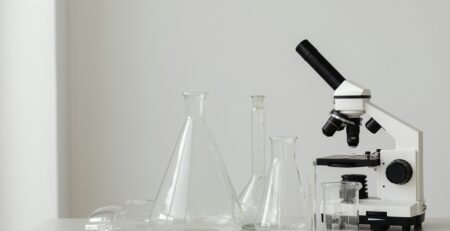4
Sep
Volumetric Flasks vs Measuring Cylinders: When Precision Matters Most
In every laboratory, accurate measurement of liquids is fundamental. While both volumetric flasks and measuring cylinders are made from borosilicate glass (BORO 3.3), their design, accuracy, and applications differ significantly. Choosing the right glassware ensures efficiency, compliance with standards, and reliable results in research, education, and industry.
Volumetric Flasks: The Gold Standard for Precision
Volumetric flasks are designed for the highest accuracy in preparing standard solutions. They comply with ISO 1042 and ASTM E288, providing precise single-volume measurements.
- Narrow neck with a calibration line ensures exact liquid level.
- Available in Class A (highest accuracy, certificate supplied) and Class B (general use).
- Commonly used in analytical chemistry, pharmaceutical quality control, and titration preparation.
Their precision makes volumetric flasks indispensable when traceable results are required in accredited laboratories.
Measuring Cylinders: Accuracy with Flexibility
Measuring cylinders (ISO 4788, ASTM E1272) are versatile tools for general liquid measurement.
- Graduated markings allow measurement of different volumes.
- Suitable for tasks where flexibility is more important than extreme accuracy.
- Widely used in educational settings, routine lab tasks, and industrial environments.
Class A cylinders offer better tolerances than Class B, but both are less accurate compared to volumetric flasks.
Why Borosilicate Glass Matters
Both instruments are typically made from BORO 3.3 glass, offering:
- Thermal resistance for heating and sterilisation.
- Chemical stability against acids, alkalis, and solvents.
- Optical clarity for easy reading of graduations.
This ensures long service life and compliance with international laboratory standards.
Comparison Table: Volumetric Flasks vs Measuring Cylinders
| Feature | Volumetric Flask | Measuring Cylinder |
|---|---|---|
| Accuracy | Very high (Class A tolerance, ISO 1042) | Moderate (ISO 4788, wider tolerances) |
| Calibration | Single mark for one exact volume | Multiple graduations for flexible volumes |
| Best Use Case | Preparing standard solutions, titrations | Routine measurements, education, general use |
| Class Options | Class A (certified), Class B | Class A (tighter tolerance), Class B |
| Material | BORO 3.3 Borosilicate Glass | BORO 3.3 Borosilicate Glass |
FAQs
Q1: Can measuring cylinders replace volumetric flasks?
Not in critical experiments. Measuring cylinders provide approximate volumes, while volumetric flasks deliver precise single volumes for analytical work.
Q2: Why are volumetric flasks more expensive?
They require tighter tolerances, individual calibration, and often certification, making them costlier but essential for accuracy.
Q3: Which class should schools use?
Class B is typically sufficient for teaching environments, while research and accredited labs require Class A.
Q4: Are both glassware types autoclave-safe?
Yes, borosilicate glass flasks and cylinders can be safely autoclaved. Care must be taken with printed graduations during repeated sterilisation.
References
- ISO 1042: Laboratory Glassware — One-mark Volumetric Flasks.
- ASTM E288: Standard Specification for Volumetric Flasks.
- ISO 4788: Laboratory Glassware — Graduated Measuring Cylinders.
- ASTM E1272: Specification for Laboratory Graduated Cylinders.
- University of Melbourne Analytical Chemistry Guidelines.
- NIST Chemistry WebBook, National Institute of Standards and Technology.

